News
The Campus Problem Didn’t Start on October 7—And It Won’t End This Year
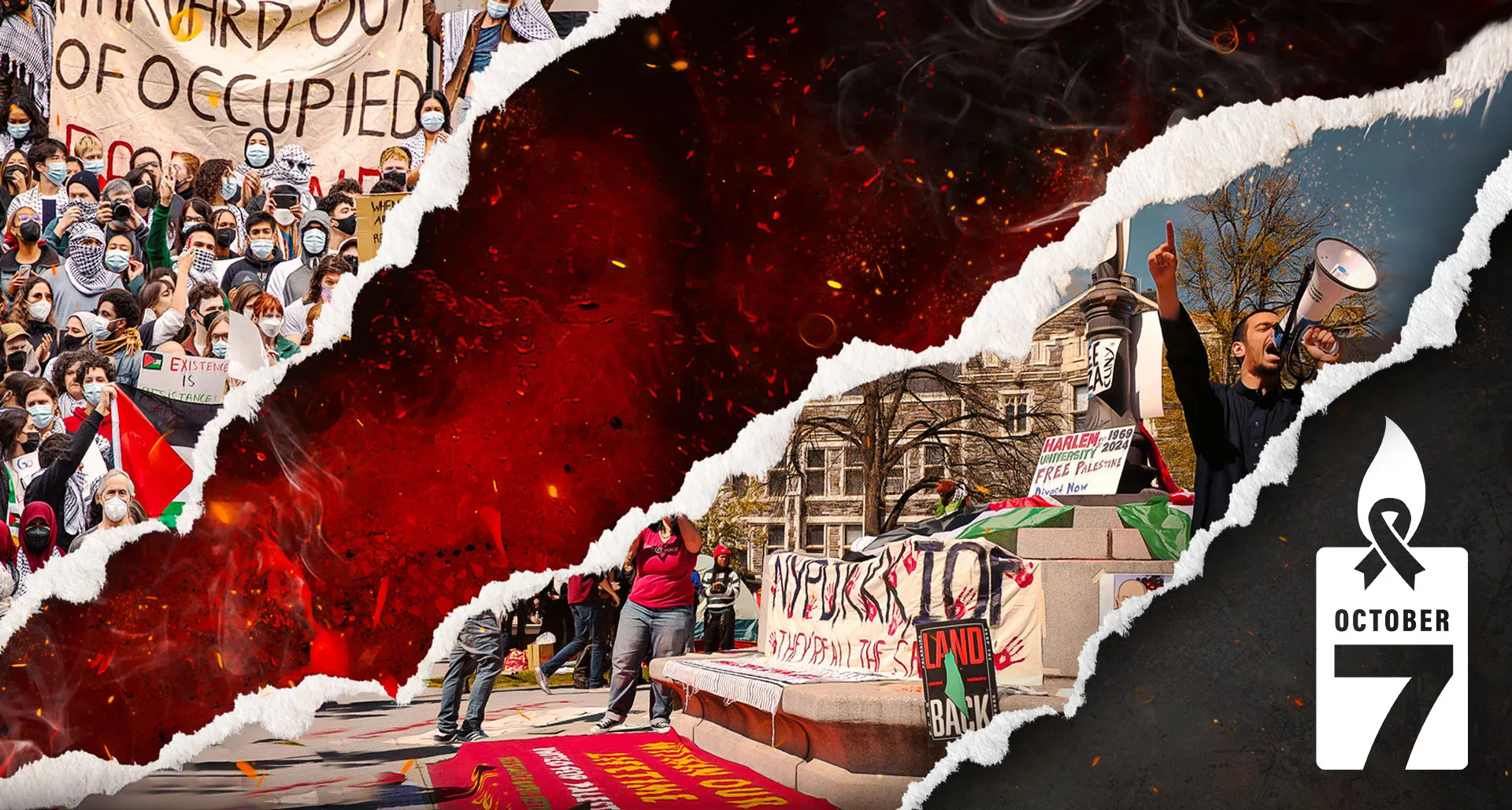
The horrors of October 7 unleashed a wave of antisemitism that, for many of us, was sadly unsurprising. We’ve seen this before.
In May 2021, when Hamas launched an 11-day war against Israel with a relentless barrage of missiles, anti-Jewish hatred quickly resurfaced. Critics seized on the conflict to vilify Israel, questioning its right to self-defense. “Why should Israel defend itself?” they screamed. The disparity in military capabilities was their rallying cry — as though Israel should willingly allow its citizens to become sitting ducks simply because defending them would result in an uneven death toll.
Their warped rationale reframed Israel’s very act of survival as aggression. To them, the lower number of Israeli casualties wasn’t a sign of successful protection but evidence of a moral failing.
The first wave of college campus protests — ostensibly in support of the Palestinians — came just days after October 7. Even as the bodies of massacre victims were still being recovered and identified, and while it remained unclear who had been killed or abducted into Gaza, American students were already gathering on campus lawns, chanting slogans like “Free, free Palestine,” “Palestine is here and proud,” and the infamous “From the river to the sea.”
The anti-Israel campus protests quickly mutated in the days and weeks following October 7. What began as rallies led by familiar groups like Students for Justice in Palestine and the ironically named Jewish Voice for Peace soon swelled into broader support from the general student population.
This escalation was enabled by the alarming inaction of college faculty and leadership, who stood by as student mobs commandeered campus quads to set up so-called “Zionist-free” zones. These makeshift encampments, they proclaimed, would remain until university administrations caved to their nebulous demands for “divestment” from companies with tenuous, if any, connections to Israel.
Yet, these student protests and the horrifying displays of antisemitism they showcased brought into sharp focus a long-festering issue that HonestReporting and others have been warning about for years: the pervasive antisemitism on college campuses.
For years, Israel’s efforts to defend itself from terrorists seeking its annihilation have been seized upon by college activists, eager to use them as a pretext for antisemitism.
During the 2006 Lebanon war, U.S. college campuses saw a surge in antisemitic incidents. A 2005 briefing by the U.S. Commission on Civil Rights had already sounded the alarm on how criticism of Israel frequently crossed the line into blatant antisemitism. The usual suspects were named: Columbia University, the University of California at Irvine, UC Berkeley, Northwestern, and others. The scenes that unfolded on these campuses mirrored the abhorrent incidents we’ve witnessed in the past year: Holocaust memorials built by students were desecrated, swastikas were carved into tables meant for Holocaust memorial candles, and antisemitic speakers appeared on campus podiums to address crowds of impressionable 18-year-olds, pushing hateful rhetoric like the “Jewish Cracker theory” and warning them to be wary of “arrogant” Jews.
There was the brick thrown through the Hillel building’s windows during Passover, visibly Orthodox Jewish students attacked, and Jewish students reciting the Kaddish at a Holocaust memorial drowned out by their peers praising Palestinian suicide bombers. In yet another vile incident, a three-foot swastika was scrawled alongside the phrase “Die Jews” on a campus wall.
🗣️ Jewish university students share their experiences on campuses in the US.
An important thread🧵 pic.twitter.com/6NooG0XFXm
— HonestReporting (@HonestReporting) May 27, 2024
How The Media Became Campus Co-Conspirators
A report released this month by the ADL lays bare the troubling state of American campuses over the past year, documenting a 477% increase in anti-Israel incidents. These incidents have included the promotion of classic antisemitic tropes, such as references to Jewish wealth and control, as well as open expressions of support for terrorist organizations like Hamas and Hezbollah.
Jewish student centers like Hillel and Chabad were frequently targeted, with at least 73 incidents directly impacting these organizations, including calls for universities to sever ties with them. Protests outside their buildings and events disrupted Jewish life across numerous campuses.
When college administrators finally took action after months of disruptions—spurred by both their disastrous Congressional testimonies and threats from high-profile donors to pull hefty endowments—university presidents began to fall on their swords and resign. Among those who stepped down were Penn’s Liz Magill and Harvard’s Claudine Gay. Some felt a flicker of hope, believing this might signal a broader recognition of the problem—that institutions were finally waking up to what Jewish students have been voicing for years.
So much easier for @thetimes‘s sub-header to blame “Jewish students and benefactors” for Liz Magill’s resignation rather than her own disastrous and morally bankrupt performance in front of Congress.https://t.co/QyN1jrXGgU pic.twitter.com/jWv688M89E
— HonestReporting (@HonestReporting) December 10, 2023
But that hope is misplaced. In truth, college campuses are just a microcosm of a wider problem, where antisemitism is widespread and Israel is uniquely vilified. This issue isn’t confined to academia—it often begins with the journalists covering these conflicts, shaping the public narrative.
The irony is that the media’s coverage of the student protests perfectly demonstrated their own anti-Israel bias. As videos flooded online—showing Jewish students being harassed and pro-terror chants echoing across the manicured lawns of America’s elite institutions—the evidence was clear for millions to see. Yet much of the international media downplayed or excused the protests, reinforcing the very problem they were supposed to report on. Even when they acknowledged the incidents, the coverage was often dismissive, minimizing the severity of the antisemitism on display.
Read More: Coverage of Campus Antisemitism Hearing Exposes Media Blind Spot
Amid its generally supportive coverage of the student protests, The New York Times sent a journalist to file a “dispatch from inside Columbia’s student-led protest”—the same college that later fired faculty over antisemitic posts. It was striking that while the reporter could freely enter the protest and write about it, any so-called “Zionist” student attempting the same would have faced immediate hostility and exclusion.
In the first paragraph of the article, the journalist conveniently witnesses a moment that supposedly proves the Columbia campus demonstrations weren’t on the whole antisemitic. Across the street from the university, a man—clearly not a student—with a large gold cross around his neck, is waving a bloodied Israeli flag and shouting, “The Jews control the world! Jews are murderers!” As if on cue, a “pro-Palestinian” student calmly walks over and tells him, “That is horribly antisemitic. You are hurting the movement, and you are not a part of us. Go away.” The man obliges and leaves.

The Guardian ran a “video guide to the protest movement,” complete with maps and infographics, informing readers that the “war in Gaza [had] unleashed the biggest outpouring of U.S. student activism since the anti-racism protests of 2020.” There it was, in the first sentence—The Guardian’s view was unmistakable: the anti-Israel protests were morally equivalent to anti-racism demonstrations. Students shouting that “Zionist pigs don’t deserve to live” were, in the eyes of the outlet, imbued with a sense of righteousness. The paper’s seal of approval, complete with a guide for others to join in, effectively encouraged more students to intimidate their Jewish peers.
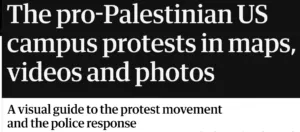
Meanwhile, a glowing feature in The New Yorker hailed the protests as a “national uprising of students to end the war in Gaza and, for some, to end their institution’s financial ties to Israel.” But that was hardly the full extent of their demands. Some college protestors went even further than the official BDS movement, calling for individual Zionists and Israelis to be banned from campuses—a stance that, according to the ADL, breaks with USACBI guidelines, which specifically advocate for “the boycott of Israeli institutions, not individuals” and “[reject] on principle boycotts of individuals based on their identity or opinion.”
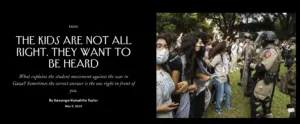
For months, the media narrative was unwavering: the students, guided by their unimpeachable moral compasses, were on the side of righteousness. Even when protests veered unmistakably into antisemitism, we were reassured that these were merely isolated incidents—just a few “bad apples.”
The prevailing wisdom, as The New Yorker so confidently asserted, was that the kids were not all right—but only because they weren’t being heard. Even as universities, after much delay, were finally forced to act—dismantling encampments, suspending students, and issuing long-overdue disciplinary actions—the media somehow continued to rally behind a cause that had rapidly devolved into the indefensible.
And now, here we are, with a new academic year just beginning.
Repercussions and Lessons Learned?
Yet, despite the break in protests and leadership resignations, the reality is that we’re likely to see a repeat of last year’s scenes—if not over the current war against Hamas, then certainly the next time Israel makes headlines.
Why? The inadequate and delayed responses from universities only served to embolden the protesters. It’s this hesitancy, coupled with words of approval from university leadership in the early stages, which allowed the demonstrations to persist for as long as they did. In fact, some of the key figures behind the protests have even been rewarded by their institutions.
For example, the Columbia University student who famously demanded “humanitarian aid” and “a glass of water” for protesters—claiming they’d “die of dehydration and starvation” without support from the administration—now teaches a required undergraduate class. At the same institution, Professor Joseph Massad, who openly praised Hamas, still holds his position teaching Middle East studies, facing no consequences. Likewise, at Cornell, the professor who described the October 7 Hamas attacks as “exhilarating” remains unpunished and continues teaching.
Second, and perhaps more troubling, is the fact that many in positions of authority at these academic institutions see no need for punishment—largely because they align with the broader sentiments expressed. The normalization of anti-Israel rhetoric has reached a point where even calls for the deaths of “Zionists” are shrugged off as poor word choice or an excess of passion, while the underlying ideology is tacitly accepted.
It’s difficult to imagine such grotesque views being directed toward the citizens of any other nation, let alone met with the same indifference or rationalization.
At the core of this issue lies the media. In Europe, the press has traditionally been regarded as the “fourth estate”—distinct from the clergy, nobility, and commoners—acknowledging its powerful role in holding other estates accountable and shaping public understanding. However, when it comes to the Israel-Palestinian conflict and the surge of antisemitism, the media has abdicated this crucial role. Where it once sought to expose, scrutinize, and challenge, it now falters. Increasingly, journalists position themselves not as impartial purveyors of truth, but as activists, emboldened by employers that sanction such partisanship.
If meaningful reform is to take root in American colleges, it must begin with a renewed commitment from the media. Journalists must reclaim their role as objective arbiters, subjecting issues to rigorous scrutiny rather than ideological alignment. The path forward requires a return to the fundamental duty of their profession: to illuminate the truth, without fear or favor.
Liked this article? Follow HonestReporting on Twitter, Facebook, Instagram and TikTok to see even more posts and videos debunking news bias and smears, as well as other content explaining what’s really going on in Israel and the region.
Image credits: JOSEPH PREZIOSO/AFP via Getty Images, Jimin Kim/SOPA Images via Reuters Connect
Business
What’s behind streamers’ hunger for live sport?
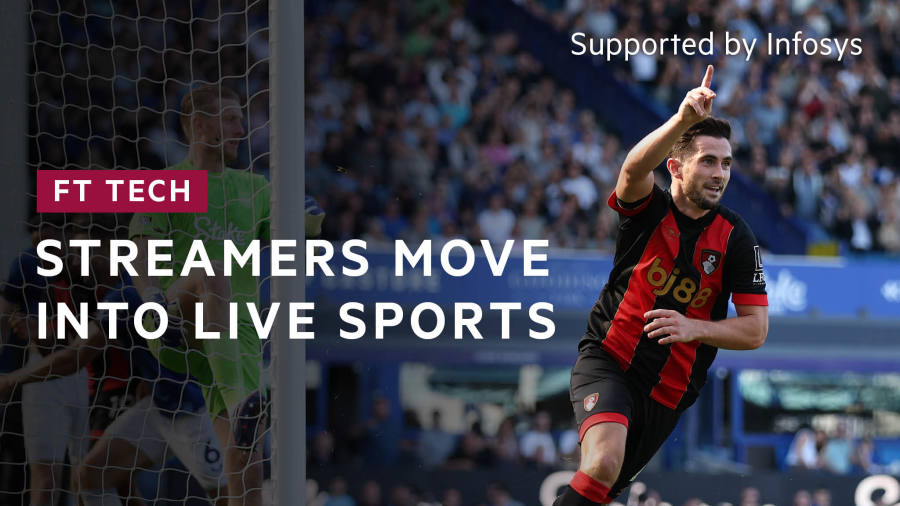
You can enable subtitles (captions) in the video player
In July this year, the NBA announced a blockbuster new media rights deal worth $76bn over 11 years. As part of that deal, Amazon will pay the NBA $1.8bn per year to screen a selection of live games in the US and internationally. It’s just another example of the way streaming platforms are pushing into live sport globally. Amazon has other deals to show the UEFA Champions League, the NFL, and the French Open tennis tournament.
Apple TV+ carries Major League Baseball matches in the US, and has global rights to Major League Soccer. Last year YouTube began showing NFL matches through a seven-year contract worth $14bn. And earlier this year Netflix announced it would be screening live WWE wrestling for $500mn a year from 2025.
Until recently, streamers had often avoided live sports, largely due to the high costs of rights and technical challenges involved. But the technology has improved to the point where former sticking points, such as picture quality and time lag, are now acceptable to many fans. And while expensive, live sports are a powerful way of targeting multiple demographic segments and driving new subscriptions. Ad revenues are also becoming an increasingly important component of streamers’ income. And few things can attract advertisers like live sporting events.
For the sports leagues, streamers have a global reach that is particularly attractive. Netflix alone has more than 270mn subscribers worldwide. But traditional broadcasters are fighting back.
Earlier this year, Fox, Disney, and Warner Bros announced the launch of a new streaming platform, Venu Sports. Although the venture is tied up in the legal challenge, alleging it is anticompetitive. Those three companies own 55 per cent of US sports rights. Meanwhile, in the UK, Sky Sports launched a new streaming service this summer to run alongside its traditional broadcast platform.
Another challenge for streamers is that their interest in sports rights has helped drive up prices. For example, between 2019 and 2024, the value of the US sports rights market grew by 54 per cent, compared to an overall TV industry revenue growth of just 15 per cent. While streamers’ spending on sports rights has soared recently, that explosive growth may ease off in the coming years, not least because many of the major sports rights deals still have years to run before renewal. But despite that, we may have reached a tipping point in the way viewers consume live sports.
News
The Papers: 'Gray ousted' and 'Israel remembers'

Sue Gray’s exit and Israel’s memorial for the 7 October attack headline several of Monday’s papers.
Travel
Trinidad and Tobago adopts India’s UPI, revolutionizing digital payments
Trinidad and Tobago has become the first Caribbean nation to adopt a real-time payments platform similar to India’s Unified Payments Interface (UPI).
Business
The symmetry and light of Edward Durell Stone’s Celanese House


By Anthony Paletta
New Canaan, Connecticut, features several of the best-known modern houses in the US. There’s Philip Johnson’s Glass House, as well as designs from the rest of the Harvard Five who made their names here in the 1940s. Of the same era, Edward Durell Stone’s Celanese House is now for sale.
This four-bedroom house has an unusual past. It was built as a display home amid a brief mid-century phase when companies would commission houses as a way of showcasing their products. Some, such as Charles M Goodman’s Care-free Homes designed for Alcoa, were intended to be replicated, with each one incorporating up to 7,500lb of Alcoa aluminium. Others were standalone showhomes, such as the Celanese House.

The company Celanese (a portmanteau of cellulose and ease) produced synthetic fabrics but also branched out into wallpaper, linoleum, carpets, paint and furniture, all of which were used liberally throughout the house. They hired Edward Durell Stone for the project, co-architect of MoMA in New York, the Kennedy Center in Washington DC and the US Embassy in New Delhi.
Stone’s approach set him apart from the Modernist architects of his day. While he embraced International Style Modernism in the 1930s, he ultimately felt that Modernism was too austere for American sensibilities. His son and fellow architect Hicks Stone explains: “My father was a progenitor of a trend in architecture called New Formalism. New Formalist buildings were typically symmetrical and monumental, and the work made references to classical architecture. It was this rejection of austere Modernism that made him commercially successful.”

Stone’s classically-influenced projects made trademark use of ornamental screens and brise-soleil, most prominently at the embassy in New Delhi but also at the Celanese House. The lattice surrounds offer both privacy and light, while 12 pyramidal skylights provide light to the interior. Floating panels beneath (once filled with hanging plants) ensure illumination without glare.
The soft light was a selling point for Joel Disend who bought the house in 2008. “The panels diffuse the light coming from the skylights so it never gets in your eyes,” he says. Disend conducted a lengthy search for a modern home after his retirement. When he found the Celanese House he asked architect Nicholas Karytinos who had renovated his prior property if he would be willing to undertake the refurbishment without affecting the property’s original design.

Many of the Celanese details — which Stone did not care for — were already gone. A linoleum floor was replaced with oak. Sliding glass internal doors, no longer necessary to keep the house warm, were removed. A covered passageway, only occasionally needed in Connecticut’s climate, was subsumed into a new kitchen.
The renovation sought to respect the clean geometry of the interior. “The kitchen had no skylight and it was quite dark so we cut one into the roof,” Disend explained. They chose not to add another pyramid to avoid affecting the symmetry of the roofline. Meanwhile the existing pyramid shingles were in poor shape and were replaced.
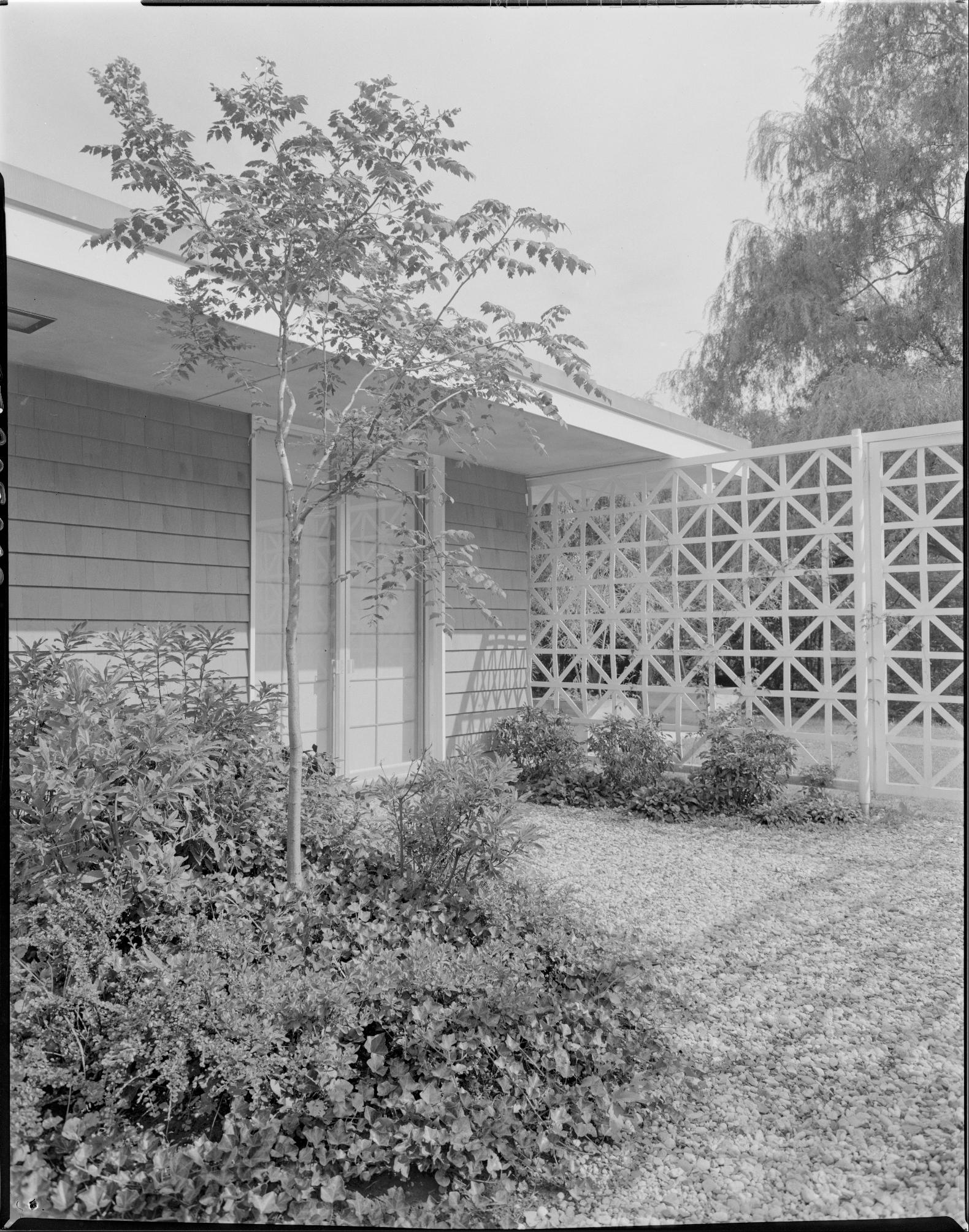
The exterior was a blank canvas. “There was no landscaping and it needed something,” said Disend, who hired a historically-minded firm to work on the house. Stephen Lederach of Arnold Associates — a company that had worked with Stone previously — planted a meadow around the existing trees and created a formal entrance with eight symmetrical Linden trees.
Hicks Stone described Disend’s renovation as “immaculate”, adding that it “extends the Modernist vocabulary with skilful details, more so than the original home, which was fundamentally a speculative house meant to showcase a manufacturer’s product line”. A historic space, sensitively updated for the modern day.
The Celanese House is on sale for $4.7mn through Melissa Rwambuya of William Raveis Real Estate.
Photography: Edward Durell Stone’s Celanese House © Smithsonian Institution, Archives of American Gardens, Maida Babson Adams Garden Photography Collection. Molly Adams, photographer; William Raveis Real Estate, New Canaan
News
Top Brit climber who went missing on 23,000ft mountain with her American pal breaks silence after rescue from snowstorm
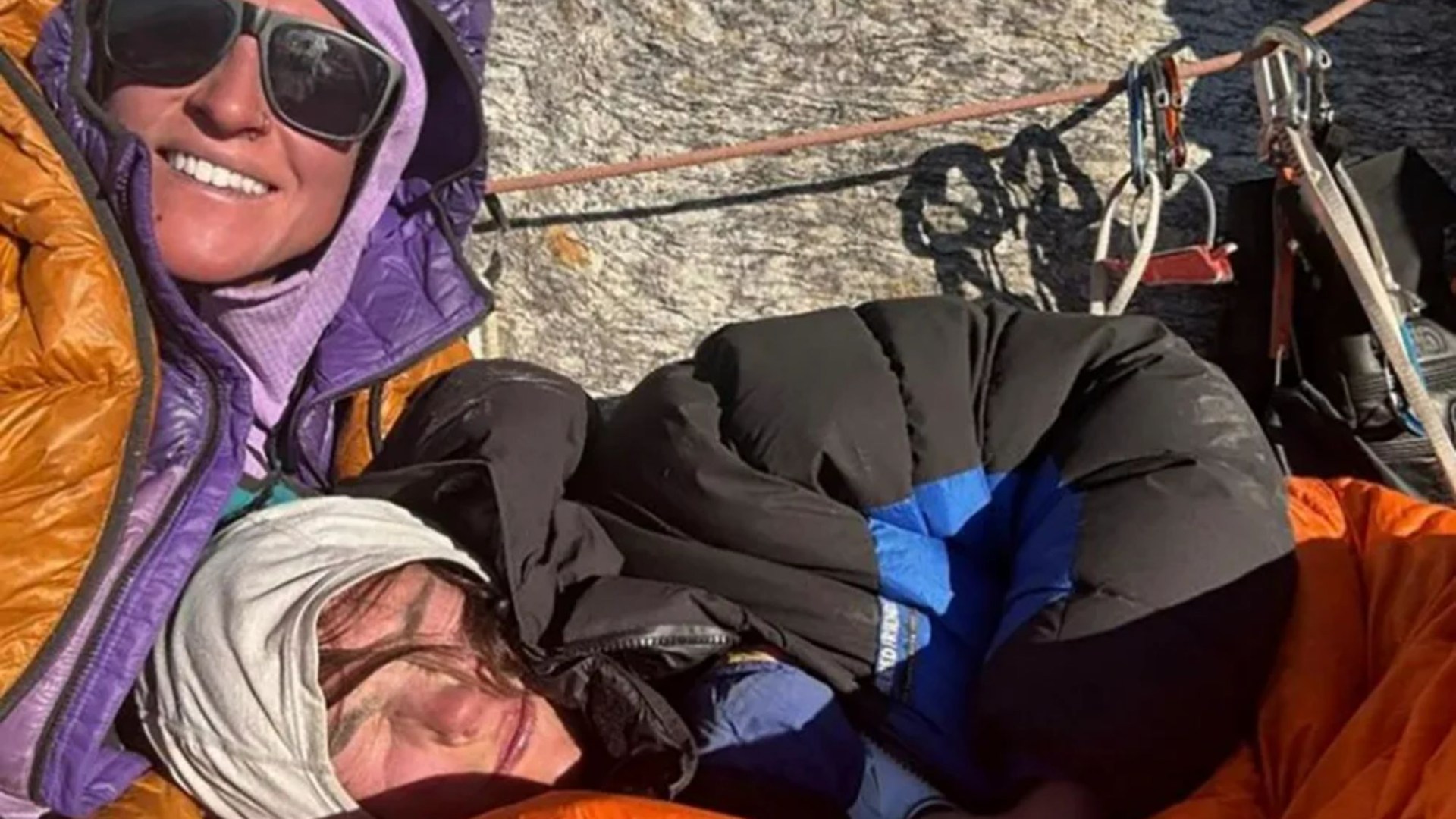
A TOP British climber revealed how she feared she was going to die after getting stuck in a snowstorm 23,000ft up a mountain.
Fay Manners, 37, went missing in northern India alongside her American pal Michelle Dvorak, 31, earlier this week.
The women spent 55 hours and two nights in the horror conditions praying to be rescued after getting trapped up the Chaukhamba III mountain.
A terrifying snowstorm battered the region on Thursday as the pair attempted to become the first people to summit the Himalayan mountain.
Fay and Michelle’s bags – containing essentials like food, their tent and climbing equipment – vanished down a ravine as the weather took a turn.
Leaving them with only a sleeping bag each and very little supplies.
read more in missing Brits
Rescue teams were deployed with the women saying they could see and hear the helicopters on several occasions despite it not being able to spot them.
They were only found on Saturday when a team of French mountaineers stumbled across them and alerted the authorities.
Fay told The Telegraph the pair being found was a “small miracle”.
The professional climber revealed that she thought she was going to freeze, starve or fall to her death as the hours ticked by.
With her and Michelle at one point being forced to attempt to cross the steep glaciers without their equipment.
The ladies knew such a perilous trek was likely to have disastrous results due to the lack of protective safety gear.
Fay first realised they were in serious danger six days into the climb when they were 2,300ft below the summit as a sudden rockfall left one of their climbing ropes severed.
The rope was helping to haul up their rucksack as it tumbled down the mountain, never to be seen again.
Inside was the pair’s tent and stove as well as bundles of warm clothes and climbing equipment like ice axes and crampons.
Losing those items left both women fearing they may fall, starve or freeze to death up the mountain.
Fay said: “I watched the bag tumble down the mountain and I immediately knew the consequence of what was to come.”
After realising the severity of their situation the women decided to stay put on a ledge so they were at least safe for a few days.
Fay had sent a frantic message with Michelle back to the base camp saying they were in trouble as the pair hoped to be rescued.
A desperate search was launched with choppers scouring the snow-capped mountainous region for any sign of the experienced climbers.
But on Friday the search had to be suspended due to the arctic weather conditions and the high altitude, a source told The Sun.
Overnight the two slept in a double sleeping bag as they huddled together to get as much warmth as possible between them.
Fay recalled by the second night: “I felt hypothermic, constantly shaking and with the lack of food my body was running out of energy to keep warm.
“Saturday morning came, we both barely survived the night.
“The helicopter flew past again but couldn’t see us. We were destroyed and we were losing faith.”
The two brave climbers began to make their way back down the mountain fearing they had no other option.
Fay described the conditions as “brutal” on Saturday.
But when all hope seemed lost, a trio of French climbers who planned on scaling the very same route miraculously found the woman.
Palin Clovis, Jacques Olivier Chevallier and Vivien Berlaud gave up on their own climbing ambitions when they heard about Fay and Michelle as they started to help look for the ladies.
Fay said: “As we were abseiling down on Saturday we could see a team of climbers coming up the mountain towards us.
“When we reached them, they said they were there to help us and I cried with relief knowing we might survive.
“They supported us to get across the steep glacier that would have been impossible without our equipment, crampons and ice axes.
“They gave us their tent and sleeping bags, gave us water and food and finally told the helicopter where to come and collect us.”
On Sunday morning at around 7am local time the two women were picked up by an Indian air force chopper on the Panpatia Bank Glacier and airlifted to the town of Joshimath.
Col Madan Gurung, who helped with the rescue operation, said the women were “exhausted” when he first saw them but “perfectly fine”.
At 7am local time on Sunday (2.30am BST), an Indian air force helicopter landed at 5,300 metres above sea level on the Panpatia Bank Glacier and airlifted Ms Manners and Ms Dvorak to safety in Joshimath, a town 21 miles to the south-east.
Col Madan Gurung, who co-ordinated the rescue operation for the Indian Mountaineering Foundation (IMF), said the women were found to be “exhausted” but in otherwise “perfectly fine” health.
Fay, from Bedford, is an pro alpinist who looks to “inspire women to pursue their interest” in mountaineering.
She moved from the UK to the Alps to follow her passion in the outdoor sport.
Her impressive climbing history includes making the first female ascent on the Phantom Direct route on the south face of the Grand Jorasses, according to her website.
She is now set to spend some time in New Delhi where she hopes to eat, relax and sleep as much as possible.
Despite the scary experience up the mountain Fay says she will continue to scale more in the future after some time off.
Michelle is also a very experienced climber and is a teaching assistant at the University of Washington, according to her Facebook.
Business
Rio Tinto makes approach to acquire Arcadium Lithium
Rio Tinto makes approach to acquire Arcadium Lithium
-

 Womens Workouts2 weeks ago
Womens Workouts2 weeks ago3 Day Full Body Women’s Dumbbell Only Workout
-

 Science & Environment3 weeks ago
Science & Environment3 weeks agoHow to unsnarl a tangle of threads, according to physics
-

 Science & Environment3 weeks ago
Science & Environment3 weeks agoHyperelastic gel is one of the stretchiest materials known to science
-

 Science & Environment3 weeks ago
Science & Environment3 weeks agoMaxwell’s demon charges quantum batteries inside of a quantum computer
-

 Technology3 weeks ago
Technology3 weeks agoWould-be reality TV contestants ‘not looking real’
-

 Science & Environment3 weeks ago
Science & Environment3 weeks ago‘Running of the bulls’ festival crowds move like charged particles
-

 News2 weeks ago
News2 weeks agoOur millionaire neighbour blocks us from using public footpath & screams at us in street.. it’s like living in a WARZONE – WordupNews
-

 Science & Environment3 weeks ago
Science & Environment3 weeks agoHow to wrap your mind around the real multiverse
-

 Science & Environment3 weeks ago
Science & Environment3 weeks agoSunlight-trapping device can generate temperatures over 1000°C
-

 Science & Environment3 weeks ago
Science & Environment3 weeks agoLiquid crystals could improve quantum communication devices
-

 Science & Environment3 weeks ago
Science & Environment3 weeks agoQuantum ‘supersolid’ matter stirred using magnets
-

 Science & Environment3 weeks ago
Science & Environment3 weeks agoITER: Is the world’s biggest fusion experiment dead after new delay to 2035?
-
News3 weeks ago
the pick of new debut fiction
-

 Science & Environment3 weeks ago
Science & Environment3 weeks agoPhysicists are grappling with their own reproducibility crisis
-

 Science & Environment3 weeks ago
Science & Environment3 weeks agoQuantum forces used to automatically assemble tiny device
-

 Science & Environment3 weeks ago
Science & Environment3 weeks agoWhy this is a golden age for life to thrive across the universe
-

 News3 weeks ago
News3 weeks agoYou’re a Hypocrite, And So Am I
-

 Sport2 weeks ago
Sport2 weeks agoJoshua vs Dubois: Chris Eubank Jr says ‘AJ’ could beat Tyson Fury and any other heavyweight in the world
-

 Science & Environment3 weeks ago
Science & Environment3 weeks agoCaroline Ellison aims to duck prison sentence for role in FTX collapse
-

 Technology1 week ago
Technology1 week ago‘From a toaster to a server’: UK startup promises 5x ‘speed up without changing a line of code’ as it plans to take on Nvidia, AMD in the generative AI battlefield
-

 Football1 week ago
Football1 week agoFootball Focus: Martin Keown on Liverpool’s Alisson Becker
-
Business1 week ago
Eurosceptic Andrej Babiš eyes return to power in Czech Republic
-

 Science & Environment3 weeks ago
Science & Environment3 weeks agoRethinking space and time could let us do away with dark matter
-

 Science & Environment3 weeks ago
Science & Environment3 weeks agoTime travel sci-fi novel is a rip-roaringly good thought experiment
-

 Science & Environment3 weeks ago
Science & Environment3 weeks agoLaser helps turn an electron into a coil of mass and charge
-

 Science & Environment3 weeks ago
Science & Environment3 weeks agoNuclear fusion experiment overcomes two key operating hurdles
-

 MMA1 week ago
MMA1 week agoConor McGregor challenges ‘woeful’ Belal Muhammad, tells Ilia Topuria it’s ‘on sight’
-

 Science & Environment3 weeks ago
Science & Environment3 weeks agoNerve fibres in the brain could generate quantum entanglement
-

 News3 weeks ago
News3 weeks ago▶️ Hamas in the West Bank: Rising Support and Deadly Attacks You Might Not Know About
-
Business1 week ago
Should London’s tax exiles head for Spain, Italy . . . or Wales?
-

 News3 weeks ago
News3 weeks ago▶️ Media Bias: How They Spin Attack on Hezbollah and Ignore the Reality
-

 Science & Environment3 weeks ago
Science & Environment3 weeks agoFuture of fusion: How the UK’s JET reactor paved the way for ITER
-

 News2 weeks ago
News2 weeks agoIsrael strikes Lebanese targets as Hizbollah chief warns of ‘red lines’ crossed
-

 Science & Environment3 weeks ago
Science & Environment3 weeks agoA new kind of experiment at the Large Hadron Collider could unravel quantum reality
-

 News3 weeks ago
News3 weeks agoNew investigation ordered into ‘doorstep murder’ of Alistair Wilson
-

 Science & Environment3 weeks ago
Science & Environment3 weeks agoUK spurns European invitation to join ITER nuclear fusion project
-

 CryptoCurrency2 weeks ago
CryptoCurrency2 weeks agoCardano founder to meet Argentina president Javier Milei
-

 Science & Environment2 weeks ago
Science & Environment2 weeks agoMeet the world's first female male model | 7.30
-

 Technology2 weeks ago
Technology2 weeks agoGet ready for Meta Connect
-

 Science & Environment2 weeks ago
Science & Environment2 weeks agoX-rays reveal half-billion-year-old insect ancestor
-

 Science & Environment3 weeks ago
Science & Environment3 weeks agoA slight curve helps rocks make the biggest splash
-
Business3 weeks ago
JPMorgan in talks to take over Apple credit card from Goldman Sachs
-

 CryptoCurrency2 weeks ago
CryptoCurrency2 weeks agoBitcoin bulls target $64K BTC price hurdle as US stocks eye new record
-

 Womens Workouts2 weeks ago
Womens Workouts2 weeks agoBest Exercises if You Want to Build a Great Physique
-

 News2 weeks ago
News2 weeks agoWhy Is Everyone Excited About These Smart Insoles?
-

 News2 weeks ago
News2 weeks agoFour dead & 18 injured in horror mass shooting with victims ‘caught in crossfire’ as cops hunt multiple gunmen
-

 Technology2 weeks ago
Technology2 weeks agoRobo-tuna reveals how foldable fins help the speedy fish manoeuvre
-

 Servers computers2 weeks ago
Servers computers2 weeks agoWhat are the benefits of Blade servers compared to rack servers?
-

 Technology1 week ago
Technology1 week agoThe best robot vacuum cleaners of 2024
-

 Health & fitness1 week ago
Health & fitness1 week agoThe 7 lifestyle habits you can stop now for a slimmer face by next week
-

 CryptoCurrency2 weeks ago
CryptoCurrency2 weeks agoEthereum is a 'contrarian bet' into 2025, says Bitwise exec
-

 Health & fitness3 weeks ago
Health & fitness3 weeks agoThe secret to a six pack – and how to keep your washboard abs in 2022
-

 Science & Environment3 weeks ago
Science & Environment3 weeks agoQuantum time travel: The experiment to ‘send a particle into the past’
-

 Science & Environment3 weeks ago
Science & Environment3 weeks agoWhy we need to invoke philosophy to judge bizarre concepts in science
-

 CryptoCurrency2 weeks ago
CryptoCurrency2 weeks agoBitcoin miners steamrolled after electricity thefts, exchange ‘closure’ scam: Asia Express
-

 CryptoCurrency2 weeks ago
CryptoCurrency2 weeks agoDorsey’s ‘marketplace of algorithms’ could fix social media… so why hasn’t it?
-

 CryptoCurrency2 weeks ago
CryptoCurrency2 weeks agoDZ Bank partners with Boerse Stuttgart for crypto trading
-

 CryptoCurrency2 weeks ago
CryptoCurrency2 weeks agoLow users, sex predators kill Korean metaverses, 3AC sues Terra: Asia Express
-
Politics2 weeks ago
UK consumer confidence falls sharply amid fears of ‘painful’ budget | Economics
-

 Womens Workouts2 weeks ago
Womens Workouts2 weeks agoEverything a Beginner Needs to Know About Squatting
-

 Science & Environment2 weeks ago
Science & Environment2 weeks agoCNN TÜRK – 🔴 Canlı Yayın ᴴᴰ – Canlı TV izle
-

 Womens Workouts2 weeks ago
Womens Workouts2 weeks ago3 Day Full Body Toning Workout for Women
-

 Travel2 weeks ago
Travel2 weeks agoDelta signs codeshare agreement with SAS
-

 Politics2 weeks ago
Politics2 weeks agoHope, finally? Keir Starmer’s first conference in power – podcast | News
-

 News1 week ago
News1 week agoUS Newspapers Diluting Democratic Discourse with Political Bias
-

 Technology1 week ago
Technology1 week agoQuantum computers may work better when they ignore causality
-

 Sport1 week ago
Sport1 week agoWatch UFC star deliver ‘one of the most brutal knockouts ever’ that left opponent laid spark out on the canvas
-

 Sport2 weeks ago
Sport2 weeks agoUFC Edmonton fight card revealed, including Brandon Moreno vs. Amir Albazi headliner
-

 Technology2 weeks ago
Technology2 weeks agoiPhone 15 Pro Max Camera Review: Depth and Reach
-

 News2 weeks ago
News2 weeks agoBrian Tyree Henry on voicing young Megatron, his love for villain roles
-

 Health & fitness3 weeks ago
Health & fitness3 weeks agoThe maps that could hold the secret to curing cancer
-

 Science & Environment3 weeks ago
Science & Environment3 weeks agoBeing in two places at once could make a quantum battery charge faster
-

 CryptoCurrency2 weeks ago
CryptoCurrency2 weeks agoRedStone integrates first oracle price feeds on TON blockchain
-

 CryptoCurrency2 weeks ago
CryptoCurrency2 weeks agoBlockdaemon mulls 2026 IPO: Report
-
Politics2 weeks ago
‘Appalling’ rows over Sue Gray must stop, senior ministers say | Sue Gray
-

 CryptoCurrency2 weeks ago
CryptoCurrency2 weeks agoCoinbase’s cbBTC surges to third-largest wrapped BTC token in just one week
-

 MMA2 weeks ago
MMA2 weeks agoRankings Show: Is Umar Nurmagomedov a lock to become UFC champion?
-

 TV2 weeks ago
TV2 weeks agoCNN TÜRK – 🔴 Canlı Yayın ᴴᴰ – Canlı TV izle
-

 Science & Environment3 weeks ago
Science & Environment3 weeks agoHow one theory ties together everything we know about the universe
-

 CryptoCurrency2 weeks ago
CryptoCurrency2 weeks agoCrypto scammers orchestrate massive hack on X but barely made $8K
-

 Science & Environment3 weeks ago
Science & Environment3 weeks agoTiny magnet could help measure gravity on the quantum scale
-

 Science & Environment3 weeks ago
Science & Environment3 weeks agoA tale of two mysteries: ghostly neutrinos and the proton decay puzzle
-

 Science & Environment3 weeks ago
Science & Environment3 weeks agoHow do you recycle a nuclear fusion reactor? We’re about to find out
-

 CryptoCurrency2 weeks ago
CryptoCurrency2 weeks agoDecentraland X account hacked, phishing scam targets MANA airdrop
-

 CryptoCurrency2 weeks ago
CryptoCurrency2 weeks agoTelegram bot Banana Gun’s users drained of over $1.9M
-

 CryptoCurrency2 weeks ago
CryptoCurrency2 weeks agoVonMises bought 60 CryptoPunks in a month before the price spiked: NFT Collector
-

 CryptoCurrency2 weeks ago
CryptoCurrency2 weeks agoSEC asks court for four months to produce documents for Coinbase
-

 CryptoCurrency2 weeks ago
CryptoCurrency2 weeks ago‘Silly’ to shade Ethereum, the ‘Microsoft of blockchains’ — Bitwise exec
-

 CryptoCurrency2 weeks ago
CryptoCurrency2 weeks agoVitalik tells Ethereum L2s ‘Stage 1 or GTFO’ — Who makes the cut?
-

 CryptoCurrency2 weeks ago
CryptoCurrency2 weeks ago‘No matter how bad it gets, there’s a lot going on with NFTs’: 24 Hours of Art, NFT Creator
-
Business2 weeks ago
Thames Water seeks extension on debt terms to avoid renationalisation
-
Business2 weeks ago
How Labour donor’s largesse tarnished government’s squeaky clean image
-

 News2 weeks ago
News2 weeks agoBrian Tyree Henry on voicing young Megatron, his love for villain roles
-
News2 weeks ago
The Project Censored Newsletter – May 2024
-

 Womens Workouts2 weeks ago
Womens Workouts2 weeks agoHow Heat Affects Your Body During Exercise
-

 Womens Workouts2 weeks ago
Womens Workouts2 weeks agoKeep Your Goals on Track This Season
-

 Womens Workouts2 weeks ago
Womens Workouts2 weeks agoWhich Squat Load Position is Right For You?
-

 MMA1 week ago
MMA1 week agoRoberto Satoshi compares losses to Francis Ngannou’s boxing run as he finally defends RIZIN title
-
Business6 days ago
Ukraine faces its darkest hour
-

 News3 weeks ago
News3 weeks agoChurch same-sex split affecting bishop appointments










You must be logged in to post a comment Login